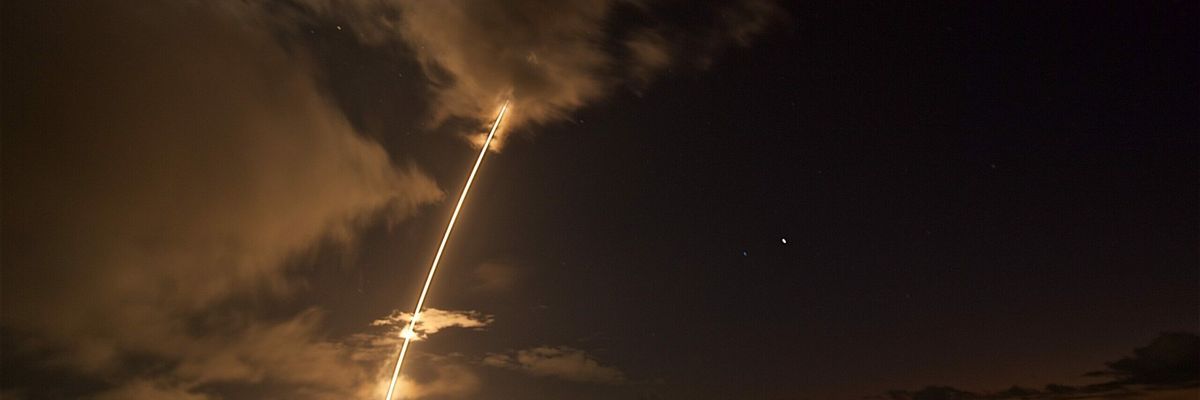A new study from the American Physical Society, the nation’s leading organization of physicists, concludes that despite 65 years of efforts and the expenditure of over $350 billion, “no missile defense system thus far developed has been shown to be effective against realistic ICBM threats.” Current and planned systems are incapable of defending the United States against even a limited attack by North Korea. They are even less capable against the more sophisticated weapons fielded by China and Russia.
As the study notes, “the explosion of even a single nuclear warhead over a major U.S. city would be an enormous disaster, potentially killing a million people and reducing 100 square miles to rubble.” None of the defenses produced or deployed by the United States could prevent such a catastrophe.
The study could have significant repercussions in Congress which approves some $20 billion a year for “missile defense and defeat” programs under the erroneous perception that these weapons work or soon could work against nuclear-armed intercontinental ballistic missiles.
Weapons designed to intercept short- and medium-range missiles, such as the Patriot and Aegis systems, have shown success in tests. Very short-range defense, such as the Iron Dome system fielded by Israel, are said to have great success in intercepting rockets that travel tens of miles, though there has been no independent verification of these claims. Long-range missiles, however, present a much more difficult challenge.
Missiles that fly more than 3000 kilometers (1860 miles) travel outside the atmosphere for much of their trajectory and re-enter at high velocity, many times greater than the speed of sound. ICBMs — missiles that fly more than 5500 km (3400 miles) — fielded by China and Russia are quit sophisticated and can use “technologies specifically designed to defeat current and future U.S. defenses against ballistic missiles, such as maneuvering warheads, multiple independently targeted warheads, and hypersonic glide weapons,” the study notes. These two nations may also soon field weapons that can defeat any known defense systems “such as short-range ballistic missiles launched from ships off U.S. coasts, nuclear weapons launched on fractional-orbit trajectories, nuclear-armed uncrewed underwater vehicles, or nuclear-armed cruise missiles.”
The detailed study, though, looked at defending against a single, more basic North Korean ICBM or a salvo of 10 such missiles. This is the focus of current U.S. missile defense programs. After a comprehensive analysis of the capabilities of the North Korean forces, including the counter-measures North Korea has likely developed, the authors found that even a defense against this limited threat is not effective and is not likely to be effective for the next 15 years.
Specifically, the scientists examined the $90 billion Ground-Based Mid-Course Defense system, consisting of 44 interceptors based in Alaska and California. This system is designed to “hit a bullet with a bullet,” destroying the warhead in the middle of its flight as it travels through the cold and darkness of space. While this capability has been shown in tests against simple targets, the deployed system has such grave issues with reliability, could be crippled by attacks on its radars, and is so vulnerable to defeat by simple countermeasures, such as decoys, that it “cannot be expected to provide a robust or reliable defense against more than the simplest attacks by a small number of relatively unsophisticated missiles,” such as the Hwasong-15. “The ability of any missile defense system to do this reliably has not been demonstrated,” the scientists note, as no system has ever been tested against realistic counter-measures, including decoys, chaff, or radar-absorbing coatings.
As recent tests have demonstrated, North Korea is moving beyond this baseline threat. U.S. intelligence estimates that North Korea “is likely already capable of launching a more sophisticated attack,” the study notes. So the scientists also examined two new ideas for adding to the deployed systems.
The first are interceptors designed to hit an enemy missile in its boost-phase, the initial period of flight when the rocket engines are firing, launching the nuclear warhead into space. This could theoretically solve the problems with mid-course interception as the missile would be hit when it is slow, hot and vulnerable rather than fast, cold and disguised. They found that any of the proposed systems using interceptors launched from ships, aircraft or from land face “very difficult technical challenges” that render them “unable to defend the entire continental United States.”
Space-based systems, also designed to intercept enemy missiles in their boost-phase, fare no better. This type of defense “would require many hundreds of weapons orbiting on space platforms to theoretically defend against a single North Korean ICBM, and thousands to defend against five ICBMs launched within a short time.” The cost to field these weapons would be enormous and they would be “vulnerable to being disabled by anti-satellite weapons.”
The scientific study is the first independent report on missile defenses from the APS since the physicists studied boost-phase defenses in 2003 and directed energy weapons in 1987. Both studies concluded that these defensive systems were unfeasible in the foreseeable future. Their findings have been upheld by the failure of these systems since.
The current report concludes that creating a reliable and effective defense against the threat posed by even a small number of relatively unsophisticated nuclear-armed ICBMs “remains a daunting challenge.” Specifically, “the difficulties are numerous, ranging from the unresolved countermeasures problem for midcourse-intercept to the severe reach-versus-time challenge of boost-phase intercept.”
Though Gen. John Hyten testified to Congress when he was in charge of these programs in 2020 that he had “100 percent confidence in those capabilities against North Korea,” the scientists found that “few of the main challenges have been solved, and many of the hard problems are likely to remain unsolved during, and probably beyond, the 15-year time horizon the study considered.”
The science is clear: For the foreseeable future an effective defense of the nation against ballistic missiles will remain a fantasy.















